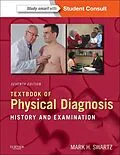Derive the maximum diagnostic information from interviewing and examining patients with Textbook of Physical Diagnosis. Employing a compassionate, humanistic approach, Dr. Swartz explores how cultural differences can influence communication, diet, family relationships, and health practices and beliefs, and demonstrates that your interpersonal awareness is just as essential in physical diagnosis as your level of technical skill. This medical reference book features numerous high-quality color images, an easy-to-use design, and detailed descriptions of exam techniques, making it an essential guide for physicians, nurse practitioners, and physician assistants. - Consult this title on your favorite e-reader, conduct rapid searches, and adjust font sizes for optimal readability. - Learn about special considerations related to patient's unique situations, such as cultural differences, nutritional status, and overall health, which may affect your approach to their treatment. - Understand the causes of the symptoms you encounter with Pathophysiology explanations. - Easily review illustrated components with abundant color photographs capturing the true appearance of various diseases. - Access coverage of complementary and alternative medicine so you can be alerted to the clinical implications of these increasingly popular modalities. - Communicate effectively in Spanish. An appendix on the examination of Spanish-speaking patients provides translations for commonly used medical phrases and questions. - Provide the best medical care through the art of interviewing and physical examination with the most recent coverage of relevant physical diagnosis standards and tests, as well as detailed discussions of key exam techniques. - Reference information on-the-go. Several chapters have been moved online, resulting in a more portable and concise print edition that focuses on core material. - View examination techniques and clinical presentations more clearly than ever before with help from high-quality color images, over 900 photographs, and line art supplementing the detailed text. - Stream more than 6 hours of in-depth video, review online-only chapters, and reference the entire contents online at Student Consult. - Gain in-context access to online videos using your smartphone by scanning accompanying QR codes located throughout the text, covering step-by-step key aspects of the physical examination for adults, newborns, toddlers, as well as important interviewing scenarios.
Inhalt
Section I The Art of Interviewing
Chapter 1 The Interviewer's Questions
Chapter 2 The Patient's Responses
Chapter 3 Caring for Patients in a Culturally Diverse Society
Chapter 4 Understanding Complementary and Alternative Medicine
Chapter 5 Assessment of Nutritional Status
Chapter 6 Putting the History Together
Section II The Science of the Physical Examination
Chapter 7 The Physical Examination
Chapter 8 The Skin
Chapter 9 The Head and Neck
Chapter 10 The Eye
Chapter 11 The Ear and Nose
Chapter 12 The Oral Cavity and Pharynx
Chapter 13 The Chest
Chapter 14 The Heart
Chapter 15 The Peripheral Vascular System
Chapter 16 The Breast
Chapter 17 The Abdomen
Chapter 18 Male Genitalia and Hernias
Chapter 19 Female Genitalia
Chapter 20 The Musculoskeletal System
Chapter 21 The Nervous System
Chapter 22 Putting the Examination Together
Section III Evaluation of Specific Patients
Chapter 23 The Pregnant Patient
Chapter 24 The Pediatric Patient
Chapter 25 The Geriatric Patient
Chapter 26 The Acutely Ill Patient
Section IV Putting the Data to Work
Chapter 27 Diagnostic Reasoning in Physical Diagnosis
Chapter 28 The Clinical Record
Chapter 29 Focusing on the Focused History and Physical Examination
Epilogue
Appendix A Commonly Abused Drugs
Appendix B Signs and Symptoms in Deficiency States
Appendix C Conversion Tables
